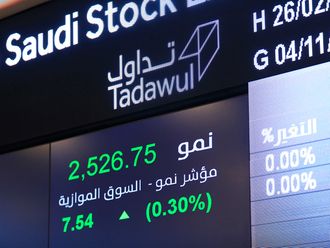New Delhi’s annual budget did not unveil any “big bang” proposals that stock markets had been speculating for weeks, but it had enough thrust on growth that should keep the bulls in good stead. Emphasis to cut red-tape and make it easier to do business would likely draw in droves of foreign investors looking to ride on the rapid economic expansion envisaged in the fiscal document.
Stocks outlook
After rallying more than 400 points on the eve of the budget, the top-30 Sensex swung widely as the budget was presented to parliament — from a high of 29,560.32 to 28,882.02 — before closing at 29,361.50, up 0.5 per cent on the day. The benchmark, which is widely tracked by foreign fund managers, has risen for a second consecutive month and is up 6.8 per cent since the close of 2014.
The broader 50-share Nifty rose 0.6 per cent on Saturday to 8,901.85 and has gained 7.5 per cent this year.
“While markets may consolidate here for a bit and wait for earnings to catch up, the bull market is in no danger,” Akash Prakash at Amansa Capital wrote in an article in the Business Standard newspaper.
The government’s decision to defer a controversial anti-tax avoidance rule by two years to April 1, 2017 should calm the nerves of foreign funds located in countries like Mauritius, and help in the flow of portfolio investment that is the mainstay for the market. Foreign funds currently own more than $330 billion (Dh1.2 trillion) of shares.
Some of the companies and stocks that should benefit from the budget are builders of houses and roads. The government has allocated Rs224 billion for housing and urban development in 2015-16, and aims to construct 40 million homes in rural areas and 20 million in urban conclaves by 2022. Larsen & Toubro, Shobha Developers, DLF Ltd, Oberoi Realty, Godrej Properties and Puravankara Projects should gain from the spending.
Similarly, IRB Infrastructure, GMR Infrastructure and Ashoka Buildcon would benefit from the government’s aim to build 100,000 kilometres of road. A focus to build 60 million toilets should cheer sanitary ware makers like Cera, HSIL, Somany Ceramics and Kajaria.
The railway budget, presented separately two days before the main budget, proposed investments of a massive $140 billion over the next five years. There will be heavy reliance on market borrowings as well as foreign and domestic private participation to boost the investment in this sector, which in the past had been drowned under populist policies.
Cheaper imports
The renewed thrust to develop the rail infrastructure will open up big opportunities for private sector companies. Steelmakers such as Tata Steel, Steel Authority of India, Jindal Steel and JSW Steel should all benefit. Additionally, these companies which are battling cheaper imports from China and Russia, can breathe a sigh of relief with an increase in import duty to 15 per cent from 10 per cent.
A move to revise capital gains taxes would help in listing of real estate investment trusts, bolstering stocks of Phoenix Mills, DLF and Prestige Estate Projects.
While an increase in excise duties on cement is negative for UltraTech Cement and Ambuja Cement, the heavy spending plans on infrastructure should provide a thrust to demand. In a similar vein, the government has earmarked a grossly inadequate $1.3 billion to fund state-run banks’ capital requirement, which means these lenders will be forced to tidy up their balance sheet and raise funds directly from the market or curb their operations.
Cigarette makers ITC and VST Industries will be hit by higher taxes, but they can diversify and make up the shortfall. ITC is particularly adept at this with its growing investment in consumer products, hotels and food items.
The writer is a journalist based in India.












